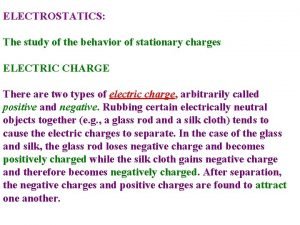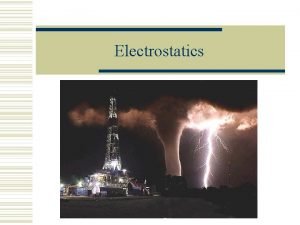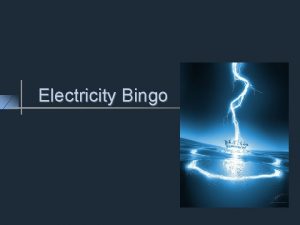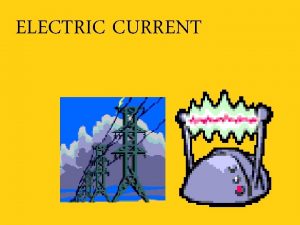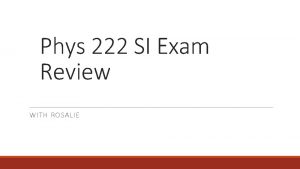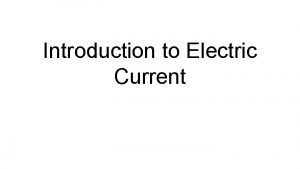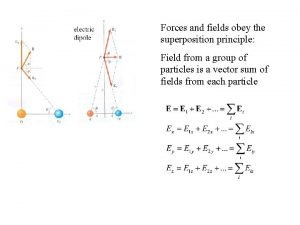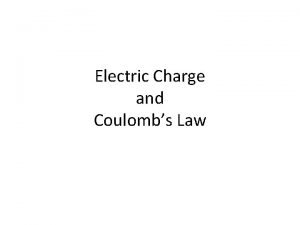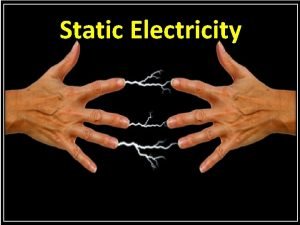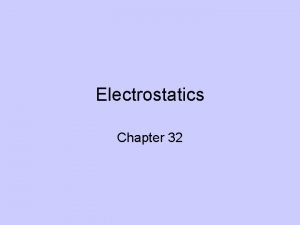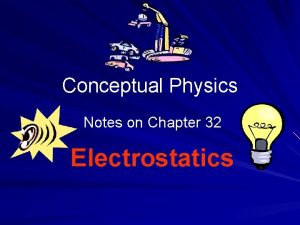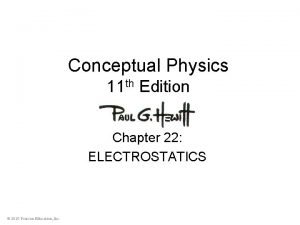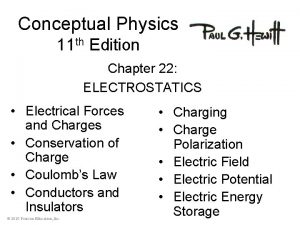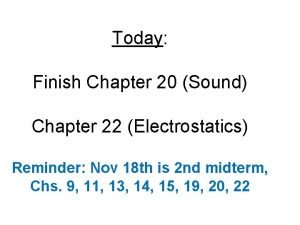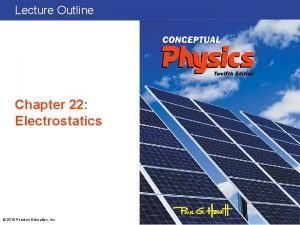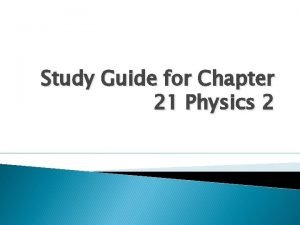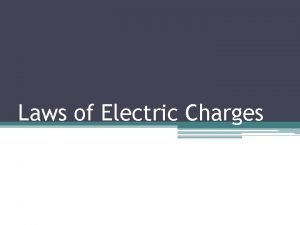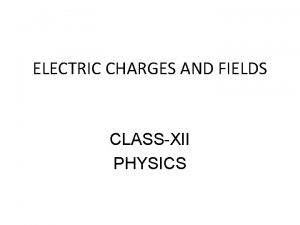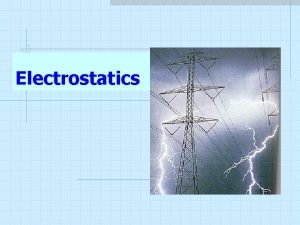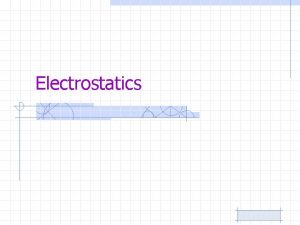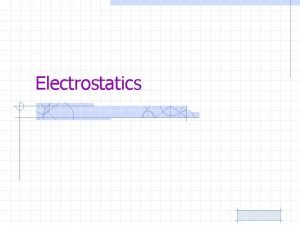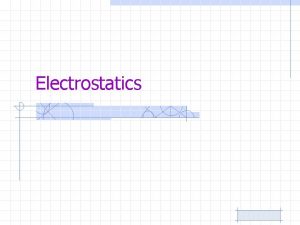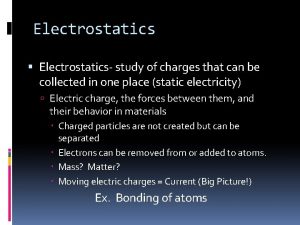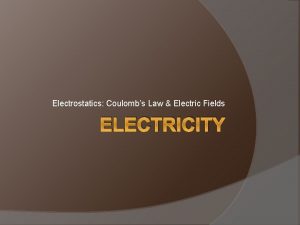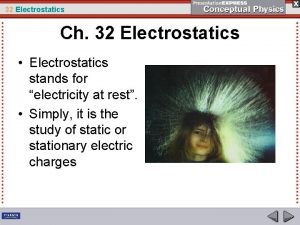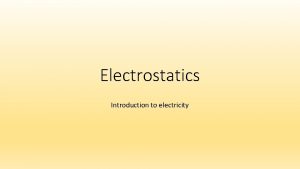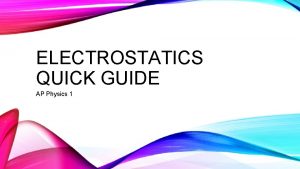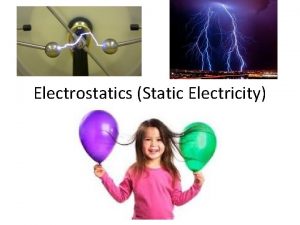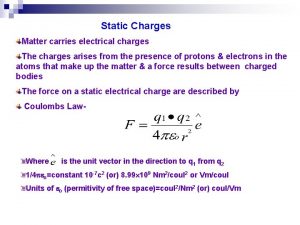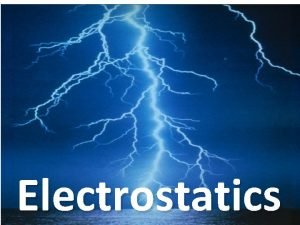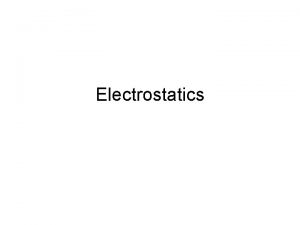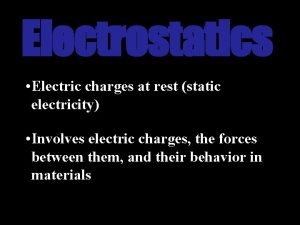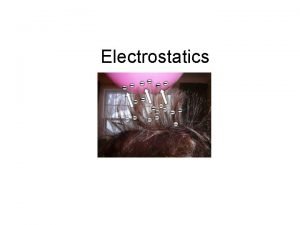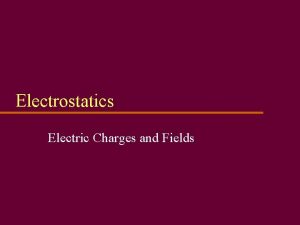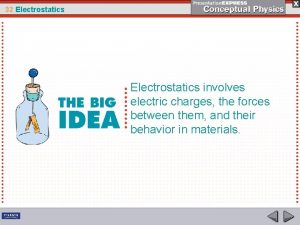Electrostatics Chapter 18 Electrostatics Study of electric charges

























- Slides: 25

Electrostatics Chapter 18

Electrostatics Study of electric charges that can be collected and held in one place.

Ben Franklin

Electrostatics 1. Demonstrate how you can pick up the paper pieces without touching them in any way with your body. 2. What is occurring at the atomic level that lets you do this? Static Electricity

Electric Charge § There are 2 kinds of electric charge, positive and negative. Interactions between + and – explain the attraction and repulsive forces § Like charges repel and unlike charges attract. § Electric charge is not created or destroyed; it is conserved. Charging is the separation, not creation, of electric charges.

Microscopic View of Charge § The atom has positive protons (p+) in the nucleus. The positive charge cannot move it is bound in the nucleus. § The atom has negative electrons (e-) in a cloud outside the nucleus. Electrons can move from atom to atom. Ernest Rutherford JJ Thompson § The atom has neutral neutrons bound in the nucleus. § p+ and e- have equal but opposite charge.

Microscopic View of Charge § p+ and e- have equal but opposite charge. § The proton mass is much greater than the electron mass § Neutral objects have an equal number of electrons and protons § When neutral objects rub together, electrons may be exchanged - Objects that gain e- become negative - Objects that loose e- become positive § CHARGE IS A CONSERVED QUANTITY. Charge cannot be created or destroyed. It can only be transferred. § Electrons are fundamental particles. Protons and neutrons are composed of fundamental particles called Quarks

Fundamental Particles (particles with no internal structure)

Electric Charge, q or Q Charge (like mass) is a fundamental property of matter § comes in two forms which B. Franklin designated positive and negative. § The electron and proton have equal amounts but opposite charge. (p+ mass is much greater than e- mass) § Charge is quantized • Smallest possible charge that can be easily isolated, designated e, is the magnitude of charge on 1 electron or (-e) or 1 proton (e). • e is referred to as the elementary charge • • e = 1. 602 x 10 -19 C The Coulomb is the SI unit of charge

Fundamental Particles (particles with no internal structure) e is considered the elementary charge because although quarks have charge that is a fraction of e, it is not possible to stably isolate a quark

Sample Problem A certain static discharge delivers -0. 5 C of electrical charge. How many electrons are in this discharge?

Conductors and Insulators § Charges transferred to one part of an insulator remain on that part. Insulators include glass, dry wood, plastics, and dry air § Charges added to a conductor quickly spread over the surface of the object. In general, examples of conductors include graphite, metals, and matter in the plasma state

Conductors and Insulators Insulator The charges are NOT free to move around but the charge can get polarized. Conductor Many of the charges free to move around

Insulators and Conductors Insulators: glass rubber oil asphalt fiberglass porcelain ceramic quartz (dry) cotton (dry) paper (dry) wood plastic air diamond pure water Semiconductors: Silicon Germanium carbon Conductors: silver copper gold aluminum iron steel brass bronze mercury graphite dirty water concrete

Insulators and Conductors

Two objects are shown below. One is neutral and the other is negative. Object X will ____ object Y. a. attract A b. repel c. not affect + + ++ + --

Electric Force Interaction between objects with electric charge § non contact force § large compared to gravity § attractive or repulsive depending on charges § can be analyzed using free body diagrams and Newton’s laws § depends on distance

Electric Force 1785 French physicist, Charles Coulomb An insulating rods with small conducting spheres suspended by thin wires. Coulomb charged the spheres by conduction and measured and quantified the electric force.

Coulombs Law. Charge MAGNITUDE Distance between charges SI units of Force: Newton (N) SI units of Charge: Coulomb (C) 1 C is the charge on 6. 24 x 1018 electrons charge of 1 e-, e = 1. 6 x 10 -19 C (elementary charge) k = 9. 0 x 109 Nm 2/C 2

Coulombs Law § Gives the MAGNITUDE of the force between 2 charges when they are at rest. The study of charges at rest is called electrostatics. § only valid for point charges (or uniformly charged spheres separated by distances much larger than the size) § Coulombs law gives force on a charge due to only one other charge. If more than one charge present, Fnet is the vector sum or SUPERPOSITION of each Coulomb force.

FG Fe Interaction between objects with MASS Interaction between objects with CHARGE Attractive and Repulsive Non-contact force Gravitational Field g = FG/m Electric Field E = Fe/q Inverse Square Law Very weak force Very strong force

Sample Problem Sphere A with charge +6 m. C is located 4. 0 cm from another sphere B with charge -3 m. C. What is the force of sphere B on A? A 6 m. C 0. 04 m FAB towards B B -3 m. C

Sample Problem-Electric force on electron by proton: Determine the magnitude of the electric force on the electron of a hydrogen atom exerted by the single proton that is its nucleus. Assume the electron orbits the proton at its average distance of r = 0. 53 x 10 -10 m. Fep + e = 1. 602 x 10 -19 C

Sample problem Two identical positive charges separated by 12. 5 cm exert a repulsive force of 1. 24 N on each other. What is the magnitude of each charge? q F = 1. 24 N 0. 125 m q F

The diagrams show two charged objects and their separation. Rank the force that the left object exerts on the right object from the STRONGEST to WEAKEST force. Explain how you made the ranking. C > A > B) A) +q +q d + 2 q C) +q 2 d B + 1/3 q + ½q 1/3 d
 Electric charges and electric forces lesson outline
Electric charges and electric forces lesson outline Study of stationary electric charges is
Study of stationary electric charges is Electron volt
Electron volt Like charges blank and opposite charges blank
Like charges blank and opposite charges blank Net movement of electric charges in a single direction
Net movement of electric charges in a single direction The figure shows three electric charges labeled
The figure shows three electric charges labeled What is the continuous flow of electric charge?
What is the continuous flow of electric charge? Superposition principle is obeyed by
Superposition principle is obeyed by Same sign repel
Same sign repel The law of charges
The law of charges Coulomb's law constant
Coulomb's law constant Electricity flow
Electricity flow Chapter 21 electric charge and electric field
Chapter 21 electric charge and electric field Chapter 21 electric charge and electric field
Chapter 21 electric charge and electric field Electric field k constant
Electric field k constant Chapter 21 electric charge and electric field
Chapter 21 electric charge and electric field Electricity at rest
Electricity at rest Chapter 32 electrostatics conceptual physics
Chapter 32 electrostatics conceptual physics Conceptual physics chapter 22 electrostatics
Conceptual physics chapter 22 electrostatics Conceptual physics chapter 22 electrostatics
Conceptual physics chapter 22 electrostatics Chapter 22 electrostatics
Chapter 22 electrostatics Chapter 22 electrostatics
Chapter 22 electrostatics Chapter 21 study guide electric fields answers
Chapter 21 study guide electric fields answers Electric field strength formula
Electric field strength formula Potential of conductor
Potential of conductor Electric potential energy
Electric potential energy

